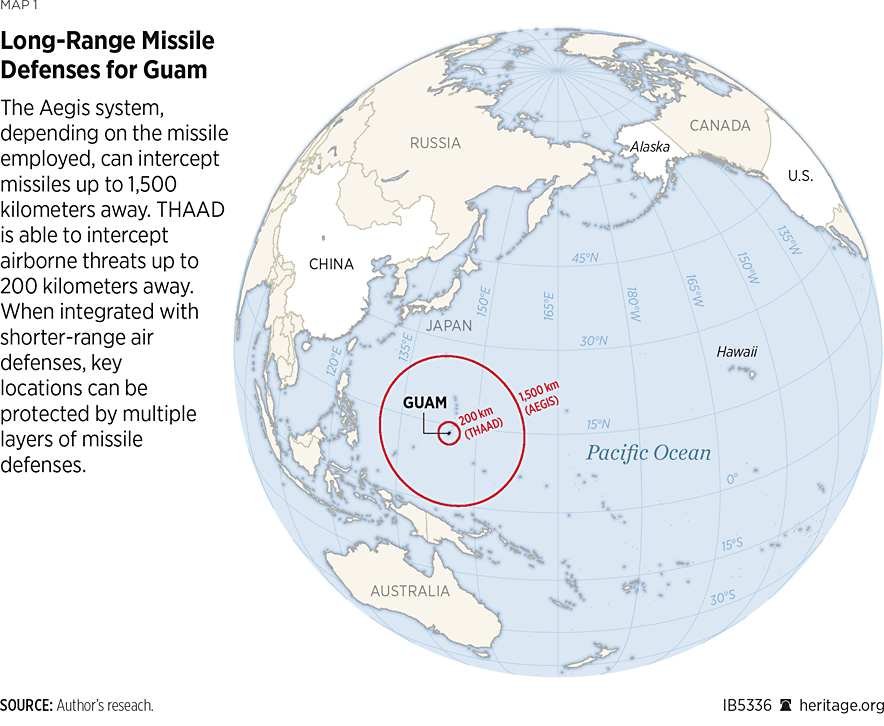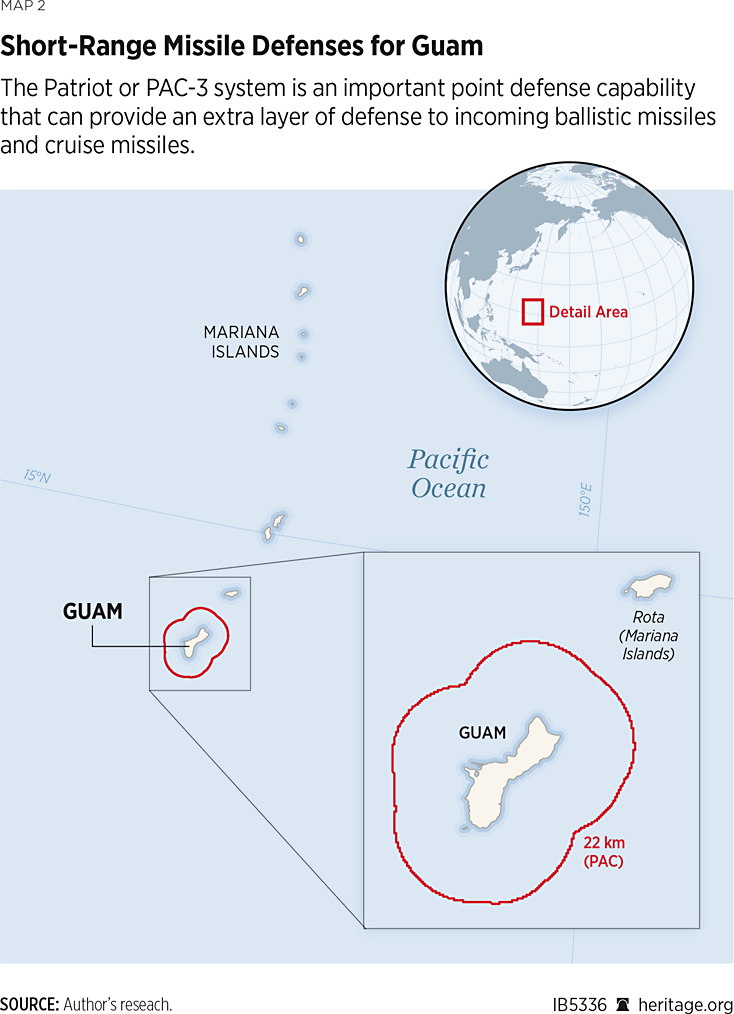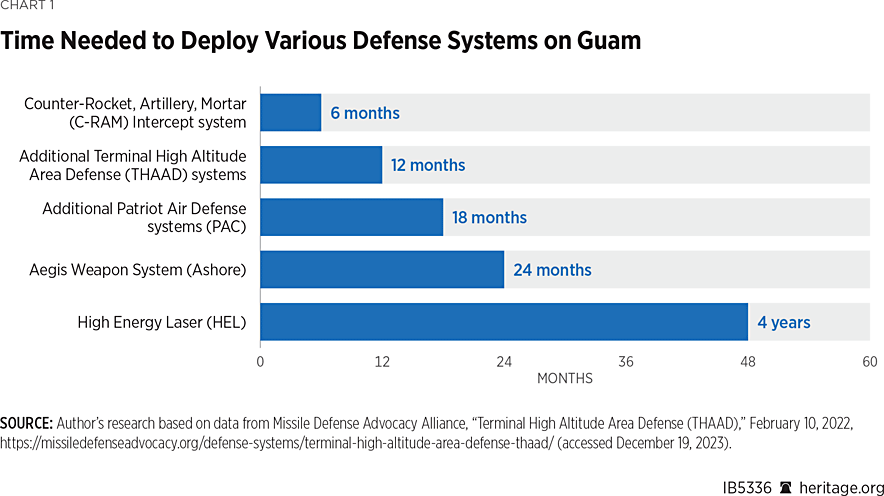Guam is a small island, just three times the size of Washington, DC, with about one-fifth of the population. The people who inhabit it are U.S. citizens and enjoy the rights and privileges of all Americans, to including national defense. Guam is remote, on the eastern edge of the Philippine Sea, a four-hour flight to Tokyo or Manila and more than seven hours to Honolulu. But this U.S. territory, home to major military bases, such as Anderson Air Force Base and Naval Base Apra Harbor, is the strategic hub of America’s combat might in the Western Pacific. Anderson’s two-mile-long runways can accommodate any aircraft in the world, while Apra Harbor’s deepwater ports and modern berths give naval vessels a place to refit, resupply, and re-arm.
Guam serves as a major logistics hub for the American military in times of peace and will be critical in times of war. For these reasons, China will almost certainly try to destroy Guam’s military infrastructure in the opening hours of any conflict with the United States, so the island’s defenses demand urgent attention.
An Enduring Challenge
Over the past two years, Heritage Foundation analysts have argued that Guam needs a full-spectrum, permanent, 360-degree missile defense capability.REF But, the Defense Department has not done enough to shore up these defenses in the interim—while the missile threat has increased.
Indo–Pacific Command (INDOPACOM), the combatant command that oversees military operations from the California coast to the Indo–Pakistani border, submitted an unfunded priorities list to Congress earlier this year that included more than $150 million for strengthened missile defenses.REF This request is in response to the ever-increasing missile threat posed by North Korea and, most significantly, by China. While both are fielding increasing nuclear-capable submarine patrols in the region, China is also deploying highly capable hypersonic missile systems, and theater-range, nuclear-capable, and conventional-capable missile systems.REF Put another way, China is putting an enormous of amount of resources into holding American and allied bases at risk, using conventional and possibly even nuclear weapons.
At the same time, American progress toward fielding a full-spectrum missile defense capability has proceeded too slowly. The Missile Defense Agency (MDA) is focused on advancing operations integration, targeting, glide-phase interception, and more potent and effective terminal defense systems. However, these improvements will take time and likely be too late to deter a Chinese aggression that by many accounts could occur before the end of this decade.REF Aegis Ashore, a missile defense capability that can track, engage, and destroy mid-course and terminal missile threats, is still years away from deployment on the island of Guam.
The MDA requested more than $800 million to design and build missile defense on Guam, including Lower Tier Air and Missile Defense Sensors, Patriot defenses, and an assortment of mid-range and indirect fire launchers.REF This investment would demonstrate that expanded integrated air defense systems are part of a broader American constellation of air and missile defenses that are designed to protect Guam, which is of central importance to the U.S. position in the Western Pacific.
In addition, expanded Terminal High Altitude Area Defense (THAAD) systems almost certainly will be part of this broader architecture. THAAD systems provide effective defenses against ballistic missiles over a broad area and augment the existing short-range, highly effective Patriot (PAC-3) air defenses on Guam. (See Map 1.) This combination is important, because THAAD can only address heavy ballistic missiles that are in a ballistic, arching trajectory. By combining advanced missile defense sensors, short-range cruise missile defenses, and broad area missile defenses, the MDA is on the right path to mitigate the cruise and missile defense threat to Guam.

However, missile defense architecture will not be complete for years, possibly well into the 2030s. A near-term, ready-to-employ defense is needed now.
The Consequences of a Strike on Guam
Should a war with China break out, conventional thinking is that China would launch a large salvo of cruise and ballistic missiles at Guam to destroy military bases there that are key to U.S. military operations throughout the Pacific. If successful, such a salvo would severely hamper the United States’ ability to project land-based air power into the Philippine and East China seas, impede the U.S. ability to flow additional munitions into theater, and deny a key port at which Naval assets could resupply during times of crisis.
This attack would not only be a modern Pearl Harbor but also a scenario in which the attacker destroys the logistics infrastructure that enabled the U.S. to eventually prevail in the Pacific War of the 1940s. Such an attack on Guam would force the United States to fall back thousands of miles from combat to bases in Hawaii, Alaska, and the West Coast. China likely knows this, which is why the People’s Liberation Army would want to take Guam off the board early in a conflict.
For this reason, in March 2021 then-Commander of the forces in the Pacific, Admiral Philip Davidson, requested before Congress a “360 degree, persistent, air and missile defense capability on Guam.”REF

Recommendations for the Department of Defense and Congress
There is an immediate way to mitigate, if not obviate, the missile threat to Guam—and it is relatively low cost and uses existing capabilities. The Department of Defense and Congress should:
- Assign an Aegis Afloat capability to Guam until permanent, robust missile defenses are put in place, as per INDOPACOM’s request in the Pacific Deterrence Initiative (PDI). The PDI calls for $9.1 billion in targeted investments, to include more than $800 million for the defense of Guam as part of a Joint Missile Defense System that can address ballistic, cruise, and hypersonic missile threats.REF This re-purposed vessel, likely an older destroyer or cruiser, would serve in a reduced operational status to provide a weapons and sensor platform for defending Guam today, while also serving as a testbed for follow-on defense systems currently being contemplated. Notably, an Aegis Afloat vessel or vessels would perform much of the missile defense command-and-control integration in the immediate term, before the MDA’s broader, advanced command-and-control and battle-management architecture is in place in the out years. By optimizing the placement of such a capability, the Defense Department could strengthen defenses in the immediate term.
- Deploy an adequate counter-rocket, artillery, and mortar (C-RAM) capability to Guam to provide added defenses against cruise missile threats. C-RAMs are short-range terminal engagement systems that resemble advanced, high-velocity, high-capacity Gatling guns. Such systems have been used effectively in overseas forward operating bases and are well suited to defend against cruise missile threats. They would be an effective augmentation for PAC-3s when it comes to smaller enemy aircraft or sea-skimming cruise missiles and drones. (See Map 2.)
- Continue apace with the MDA’s sequenced approach that integrates Patriot point defenses and THAAD, with the ultimate goal of the MDA providing a 360-degree missile defense capability on Guam.
A $100 million cost is significant, but the defense of Guam is imperative, due to the fact that it is American soil and is the lynchpin of America’s ability to project power in the Western Pacific. Congress should appropriate the resources required to protect Guam in the 2025 National Defense Authorization Act, while long-range plans for a total missile defense for the island go into place. (See Chart 1.)

Robert Peters is Research Fellow for Nuclear Deterrence and Missile Defense in the Douglas and Sarah Allison Center for National Security at The Heritage Foundation.



